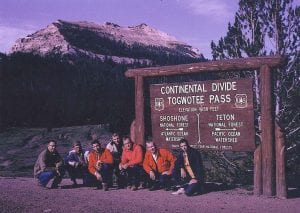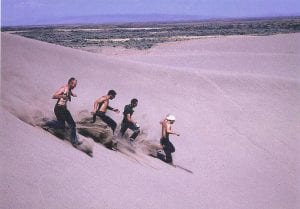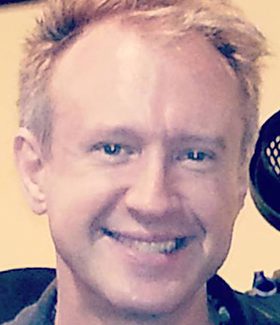Like Father, Like Daughters: The University Experience Transcends Generations
MACOMB, IL – If ever the catchphrase “following in your father’s footsteps” applied to someone connected to Western Illinois University, it would be the late Dean Emeritus of Graduate Studies Hank Sather, and his daughters, Kristi, Signe and Ingrid.
Not only did Sather influence nearly a decade of students in the University’s biological sciences department, his daughters followed his example to earn degrees in and advance to careers in biology.
A lifelong educator, Sather went beyond the traditional classroom with his students for a series of summer field trips to America’s west to study wildlife and biology. Through these trips, strong lifelong relationships were formed that led to many reunions over the years.
The Early Years

Students of the late Dean Emeritus of Graduate Studies Hank Sather met for reunions for many years after the students graduated.
As Sather’s teaching career grew, so did his young family with his late wife, Shirley; adding daughters Kristi and Signe while he was working in Nebraska, and later, daughter, Ingrid after they moved to Macomb. The daughters attended the Western Laboratory school. Kristi is a 1974 and 1983 WIU graduate, with bachelor’s degree in biology and a master’s degree in zoology. She married 1981 WIU graduate R. Daniel Smith, who received a botany degree.
Sather and his family arrived in Macomb in 1955, and he served as a biology professor until 1964, when he became the dean of WIU’s School of Graduate Studies. He retired from WIU in 1979. Between those years is a distinguished career of impacting the lives of students and teaching natural resource lessons that would not only change the academic experience for numerous WIU students, but their life and career paths as well.
One of the highlights of Sather’s career, according to his three daughters, is the field trips he took as he loaded multiple sets of students into University vans and station wagons and headed northwest from town to visit sites vital to the study of biology.
“It was important to my dad to get these kids out on these trips because many had never seen anything but western Illinois,” said Signe. “He wanted to instill an interest and appreciation for fish and wildlife.”
But these trips to the picturesque American locations were not just a vacation. The daughters remember their father lecturing students and working with professionals at wildlife refuges and other sites to add to his students’ education.
“Students spent hours with other professionals, using the tools dad gave them, and information from the lectures, about the real-time applications of the theories they learned,” said Kristi. “It was intentional to develop leadership training and service learning.”
The multi-week field trips were held in 1958, 1959, 1961 and 1964, and besides a learning experience, these trips bonded professor and students. As a result, many members gathered with Sather and his family after his retirement for reunions to maintain their connection.
Among those WIU alumni are Bill Shake and Al Farris, both who received bachelor’s degrees in zoology in 1964 and master’s degrees in biological sciences in 1967, and the late Glen Magnuson, who received his bachelor’s degree in botany in 1962.
Continuing the Relationship
After leaving WIU, Shake went on to have a 37-year career with the U.S. Fish and Wildlife Service; Farris was an administrator with the Iowa Department of Natural Resources and Magnuson had a distinguished career as an administrator of Cargill and the Belgian company, Unifert, before opening his own company Magnuson LLC.
Shake and Farris graduated from Western High School in 1960 and entered WIU that fall. Both decided they wanted to be wildlife biologists and signed up as zoology majors, with Sather as their advisor.
“It was not long before I became a good friend and he was a true mentor throughout my bachelor’s and master’s degrees,” said Shake.
He recalled Sather, who he refers to as “Doc,” was scheduled to take students on one of his summer trips, when it was announced the trip was cancelled because Hank needed to stay in Macomb to teach.
 “Doc had a summer set of courses traveling west from Macomb for six weeks,” said Shake. “He had us all signed up when the WIU president said Doc was going to cancel our trip and teach high school teachers. Al Farris and I went to the president’s office and pleaded our case. The president picked up his phone and assigned another teacher to teach the course, and called Doc to say the trip was on.”
“Doc had a summer set of courses traveling west from Macomb for six weeks,” said Shake. “He had us all signed up when the WIU president said Doc was going to cancel our trip and teach high school teachers. Al Farris and I went to the president’s office and pleaded our case. The president picked up his phone and assigned another teacher to teach the course, and called Doc to say the trip was on.”
During that trip, students first stopped in Fremont, NE, and Halsey National Forest.
“On the Valentine National Wildlife Refuge, Al and I did a muskrat density study as a part of our course requirements,” said Shake. “Then it was onto Wyoming Targhee National Forest, Grand Tetons, Yellowstone, Red Rocks National Wildlife Refuge in Montana – we had our final exams in a cabin in the Black Hills.”
Shake said Sather had a way of immersing his students in first-hand experiences that created a lasting understanding of what would be expected of them if they went to work as a wildlife biologist for a state or federal agency.
Farris said his first encounter with Sather was during high school biology when he visited his campus laboratory.
“My friend Jim Walters and I were going to collect mammals and skulls for our science project,” he said. “Arrangements were made for us to visit and meet with Dr. Sather. He showed us around his lab and the appropriate way to prepare the skins and skulls. He was very kind and helpful to a couple of high school kids.”
Farris said he and Shake took every class Sather taught and the men said by the time they enrolled at WIU, the summer field trips were “legendary.”
“Most of us could hardly wait to participate,” Farris said. “It was the opportunity to see and learn from real, in the field practitioners in a variety of states and competition for an opportunity to participate was real. Dr. Sather arranged for us to meet with Nebraska field biologists, refuge personnel at Valentine National Wildlife Refuge, tour a winter elk range in Idaho, stay in an Idaho Fish and Game cabin at Island Park, visit Red Rocks National Wildlife Refuge, and learn from South Dakota wildlife personnel in the Black Hills. It was the upfront, on the ground experience that showed us what our profession was all about.”
Farris said Sather helped arrange funding for his master’s degree research at WIU, and then Sather was named dean of Graduate Studies.
“Fortunately, Dr. John Warnock came to WIU and accepted me as his first graduate student,” he said. “I was so fortunate to have Dr. Sather and Dr. Warnock for inspiration and as mentors.”
Magnuson’s wife, Trudy, said her husband always considered WIU as the place where he “got his start” and thoroughly enjoyed the field trips and the reunions. He later went on to get his master’s and doctoral degrees in genetics.
A Legacy of Memories
After Sather passed away in 2018, Ingrid began going through his extensive collection of papers and photographs, many which contained correspondence with the stops made along the trips. The three women pointed out that these trips were planned during a time before the Internet and had to be organized by handwritten letters and/or telephone calls. Sather also had to get scientific permits to allow students to collect samples during the trips.
Mixed in the papers found by Sathers’s daughters was a copy of his life story he had penned in 2005. The story includes a narrative about how the first field trip was organized in 1958.
 “It was also the summer of 1958 that Dr. John Parsons and I organized the first of several summer field trips to western states,” he wrote. “Inasmuch as I had good contacts with ecologists in Nebraska, Wyoming, Idaho, Montana and South Dakota, I made the arrangements for this trip. Not only did these state and federal ecologists have an intimate knowledge of the areas we were to work in, but they also usually had vehicles that could get into areas that ours could not. These were trips that included lectures, collection and preservation of specimens (primary mammals, fisheries and reptiles) and all the duties associated with camping (except for using my brother’s cabin in the Black Hills of South Dakota, we slept out in tents).”
“It was also the summer of 1958 that Dr. John Parsons and I organized the first of several summer field trips to western states,” he wrote. “Inasmuch as I had good contacts with ecologists in Nebraska, Wyoming, Idaho, Montana and South Dakota, I made the arrangements for this trip. Not only did these state and federal ecologists have an intimate knowledge of the areas we were to work in, but they also usually had vehicles that could get into areas that ours could not. These were trips that included lectures, collection and preservation of specimens (primary mammals, fisheries and reptiles) and all the duties associated with camping (except for using my brother’s cabin in the Black Hills of South Dakota, we slept out in tents).”
Sather further outlined the stops on these trips, noting interesting stories from along the way, including the live musical entertainment and unique people they encountered and the written tests he gave students.
“I continued to do field trips out west during the summer in 1959 (7 students), 1963 (8 students) and in 1964 (7 students),” he wrote. “Most of these students went onto successful careers in universities, the federal and state government, medicine, etc. At the time of this writing (2005) most of them are now retired.”
Sather’s daughters said they were struck by how their father expanded his teaching capacity to create an experience that stayed with so many students for so many years. The trio said their family vacations turned into trips similar to his field trips, including his six-month sabbatical to sections of Lake Erie.
“I wanted to be just like him when I was 6,” said Signe. “We visited Florida, Canada, Red Rock Lakes National Wildlife Refuge; places where he had visited before with students.”
The Sather sisters said it has been fun to look back on the trips their father led for students and the creative ways he found to teach them.
“He liked meeting people and having his students learn about managing wildlife,” said Ingrid. “They had hands-on experiences at each place.”
 The field trips ranged from four to eight weeks and Ingrid said she has enjoyed looking back on the papers her father kept that students wrote along their journeys.
The field trips ranged from four to eight weeks and Ingrid said she has enjoyed looking back on the papers her father kept that students wrote along their journeys.
“When dad became dean, he hated to give up the trips,” said Kristi.
In addition to his storied academic career, Sather had played football for the University of Nebraska and was an Army Air Corps veteran of WWII, serving as a staff-sergeant tail gunner on a B-17 Flying Fortress on his squadron’s lead plane. During his service, he received the Distinguished Flying Cross, Air Medal with Four Clusters and the Good Conduct Medal for his service.
After Sather retired from WIU, he and his daughters eventually moved to Boise, ID. He devoted time, after his retirement, to working on wetland inventory, classification and value assessments.
At age 90, he went on an Honor Flight and was able to visit the WWII Memorial in Washington, DC.
To read Hank’s obituary from 2018, visit bit.ly/2PzCtpU.









